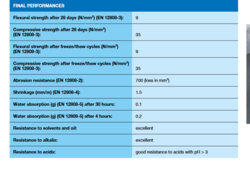No head butting going on here... I accept that from a technical perspective you could use 1 joint. In ust think 2, evenly spaced, making 5mx5m bays would make it more robust. My real concern though is the 3mm grout joint. I'e just done some calcs based on the coefficient of linear thermal expansion of porcelain, wich is about 4x that of the screed. Each tile based on a change of temperature from 5degrees up to 25degrees (I.e a cold floor up to an operational surface temp) would expand by 0.64mm so about 0.3mm in each direction. That is 10% of the grout joint width at 3mm which will place huge stress on the joint. I don' know the compressive strengths or coefficient of linear compaction for grout so csnnot say if it will accomodate that level of movement. It does worry me though...
I guess, having a slightly paranoid streak I just don' want the floor to fail and the screed to get the blame as it often does...
Hi Alan,
I've found some info (picture attached) on the compressive strength for Mapei ultra colour grout as an example.
Unfortunately, couldn't find any data on BAL, Weber, Ultra, and Nicobond to compare but pretty sure they all in the same category.
In you opinion....
Would the 3mm joint filled with Mapei accommodate that level of movement.

